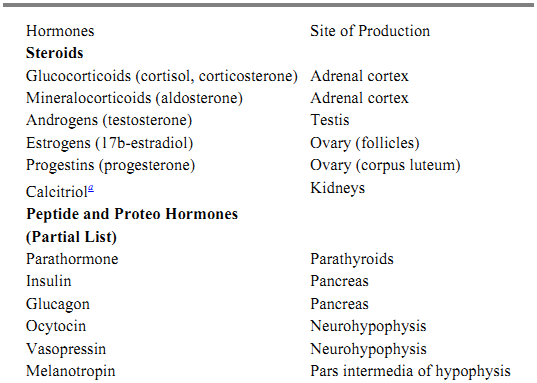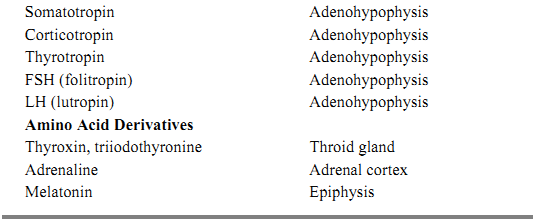


 النبات
النبات
 الحيوان
الحيوان
 الأحياء المجهرية
الأحياء المجهرية
 علم الأمراض
علم الأمراض
 التقانة الإحيائية
التقانة الإحيائية
 التقنية الحيوية المكروبية
التقنية الحيوية المكروبية
 التقنية الحياتية النانوية
التقنية الحياتية النانوية
 علم الأجنة
علم الأجنة
 الأحياء الجزيئي
الأحياء الجزيئي
 علم وظائف الأعضاء
علم وظائف الأعضاء
 الغدد
الغدد
 المضادات الحيوية
المضادات الحيوية|
Read More
Date: 28-5-2021
Date: 24-4-2021
Date: 26-4-2016
|
Hormones
Hormones are chemical signaling molecules that regulate metabolism, growth, and differentiation in multicellular organisms (1). Hormones are produced in specialized cells of the endocrine glands and reach their target cells by way of the blood circulation. The term “hormone” is sometimes applied loosely to encompass various other regulatory compounds, including those of lower animals and plants, that show comparable effects. Several hormones (primarily steroid hormones and thyroid hormones) are transported in the circulation while bound to specific binding proteins. These proteins serve as hormone depots, releasing the hormone when needed and also protecting it from rapid inactivation. Most hormones are either steroids or peptides and proteins (Table 1). Adrenaline, the thyroid hormones, and melatonin are hormones derived from amino acids. In insects and crustaceans, peptide hormones, steroid hormones (ecdysteroids), and sesquiterpenoid derivatives (juvenile hormones) have been isolated.
Table 1. List of Hormones and Sites of Production


a Steroid derivative, not a steroid, but with molecular action like steroid hormones.
The steroid hormones are derived from cholesterol by a series of enzymatic reactions that take place in the cytosol and in mitochondria of primarily cells of the adrenal cortex, ovary, and testis. In some cases, the steroid hormone must be subjected to modification in the target tissue, either to be activated or to produce a more active derivative. The steroid hormones are inactivated mainly in the liver in various ways—for example, by reduction of keto groups or unsaturated double bonds, ring hydroxylation, oxidation of hydroxyl groups, and cleavage of the side chain. They are excreted after being conjugated to sulfuric or glucuronic acids. Most of the peptide and proteohormones are synthesized in the form of precursor proteins (prohormones) and are stored in the endocrine cell. Before being released into the circulation, the prohormones are cleaved to the active hormone. Their inactivation involves proteolytic cleavage by intracellular proteinases. The production and release of many hormones is controlled by “tropic” hormones produced by the hypophysis, an endocrine “master” gland; this phenomenon is known as hormone hierarchy. The hypophysis responds to chemical signals (metabolites, hormones) from the periphery or to neuroendocrine stimuli from the hypothalamus (liberins, which act positively on hypophysial hormone release, and statins, which inhibit their release). From an evolutionary standpoint, the endocrine system developed earlier than the other two major regulatory systems of higher organisms, the nervous and the immune systems.
The molecular mechanism of hormone action depends on the physical chemical characteristics of the hormones. Steroid and thyroid hormones, which are hydrophobic, can enter the cell and bind intracellularly to their respective hormone receptors (2-4). These proteins belong to the superfamily of nuclear receptors and are present in the quiescent cell as complexes with other proteins, among them heat-shock proteins. This complex dissociates upon binding of the hormone ligand, the receptor homodimerizes, and it then binds to specific nucleotide sequences, the hormone response elements (HRE). These represent receptor-activated enhancer elements situated at varying distances from the promoter of the hormonally regulated genes. Interaction of the hormone–receptor homodimer complex with the HRE results, in a still undefined way, in either stimulation or inhibition of gene transcription, and consequently of expression of the gene. The nature of the protein synthesized determines the phenotypic effect. The hydrophilic hormones (peptide and proteohormones, adrenaline and melatonin) cannot enter the cell, but bind to membrane hormone receptors. This results, by way of a G-protein effector system, in activation of enzyme systems (eg, adenylate cyclase, phospholipase C) generating second messengers, which are allosteric effectors of protein kinases primarily (5-7). The hormonal effect depends upon the nature of the phosphorylated protein. One class of membrane receptors eg, the insulin receptor, first dimerizes upon binding the hormone and is then autophosphorylated; in this state, it can phosphorylate and activate other intracellular proteins.
Analogues of hormones can be either more or less potent than the natural hormones, or they can be inhibitors of hormone action; many have been synthesized and used in research or as therapeutics.
The more potent analogues of steroid hormones exhibit higher affinity for the cognate receptor than the natural hormone or greater stability, due to lower rates of inactivation and excretion. Important examples of such analogs are diethylstilbestrol, an estrogen, and dexamethasone and triamcinolone, glucocorticoids. Competitive inhibitors also bind with high affinity to the receptor but cannot elicit the hormonal effect; they can inhibit receptor homodimerization, binding of the receptor to hormone response elements, or interaction of the receptor with the transcriptional machinery. Some such inhibitors (Fig. 1) that have found clinical application include the antiestrogen ICI 182780 used in treatment of breast cancer, the antiandrogen cyproteron in prostate cancer and hirsutismus, and RU486, an antiprogesterone compound used in pregnancy termination.

Figure 1. Synthetic hormone antagonists.
References
1. E. T. Baulieu and P. A. Kelly (eds.) (1990) Hormones: From Molecules to Disease, Hermann, Paris.
2. E. M. Evans (1988) Science 240, 889–895.
3. D. J. Mangelsdorf et al. (1995) Cell 83, 835–839.
4. M. Beato, P. Herrlich, and G. Schutz (1995) Cell 83, 851–857.
5. A. Hall (1990) Science 249, 635–640.
6. W. J. Tang and A. G. Gelman (1992) Cell 70, 869–872.
7. N. Divecha and R. F. Irvine (1995) Cell 80, 269–278.



|
|
|
|
علامات بسيطة في جسدك قد تنذر بمرض "قاتل"
|
|
|
|
|
|
|
أول صور ثلاثية الأبعاد للغدة الزعترية البشرية
|
|
|
|
|
|
|
مكتبة أمّ البنين النسويّة تصدر العدد 212 من مجلّة رياض الزهراء (عليها السلام)
|
|
|